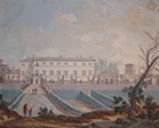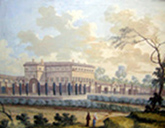
 |
|||||||||
|
History of Villa Aureli |
  |
Villa Aureli was built on the remains of a number of etruscan (6th century BC), roman and middle-age settlements, whose traces are still visible today.
The building that exists today dates back to the early 16th century, and was first erected by the mercenary commander Giovanni Gregori, who served with the Venetians in the wars against Louis XII of France, and died beneath the walls of Verona. Together with the surrounding land it became a property of the Aureli family when Filomena Gregori married Ottaviano Aureli, in the second half of the century. Ottaviano's great-grand son, the count Sperello Aureli (1722-1791), around 1750 transformed the original austere tower and the surrounding buildings into a pleasant and colorful villa, adorning it with frescoes, prints, stuccowork and furniture that can all still be admired today.
From an inscription, found behind a picture in the ground floor drawing room, we know that in 1758 the works of transformation of the villa and the garden, started by Sperello's father Claudio at the beginning of the century, were over. The restoration works were supervised by the architect Costanzo Batta, a pupil of the architect Murena. Sperello also created the "giardino all'italiana" in its present design and added the large "orangerie" to the main building. He was an exceptionally cultivated man, highly interested in arts and literature, and assembled a fine library, part of which is still in the Villa. Sperello died heirless and his sister Celidora Alfani inherited the Villa.
The Alfani kept it up to 1874 when it was purchased by the Count Cesare Meniconi Bracceschi and his wife Maddalena Savorgnan di Brazzą, sister of Pietro Brazzą, the famous explorer of Congo, after whom the city of Brazzaville was named. Maddalena adorned the front of the Villa by adding delightfully shaped balconies to the second floor windows. In 1918 her daughter Anna Meniconi Bracceschi married the count Pieralvise di Serego Alighieri, at the time the only descendent of the poet Dante, who lived in a property near Verona that had been purchased in 1352 by Pietro, the son of the great poet. Anna used to come to Villa Aureli only for short periods, but she loved it dearly and her gift to the house were the colorful ceramic floors, designed by her friend, the Marchese Raimondo Lignola, and made in Vietri, near Neaples.
During World War II, the Villa was occupied by the local Headquarters of the German Army, and then by Allied Forces, including British, American, Australian and New Zealander officers and troops. It suffered little damage, and all the precious furniture was saved by the faithful gardener Adolfo Guelfi, who hid it behind fake walls. The family's gratitude to Adolfo is witnessed by a plaque on the front of the dependence where he lived.
At the end of the war the count Leonardo di Serego Alighieri, son of Pieralvise, and his spouse Laura Guarienti di Brenzone choose Villa Aureli as their residence, and devoted their lives to the restoration and conservation of the villa, bringing it back to the splendors of the 18th century. The restoration work is being continued by their son, Sperello, the actual owner: the structure, the fronts and the roof of the Villa have been restored during 2002 and 2003. In 2006 Adolfo's house has been restored and divided into two apartments.
References (click on references to display text and images):
Alberto Durante, Ville parchi e giardini in Umbria, Pieraldo Editore, 2000
Demeures & Chateaux, No. 71, Mars-Avril 1993
Departures, No. 34, July-August 1995
Country Life, Italian Number, February 27, 1986